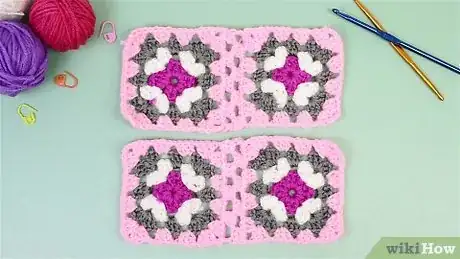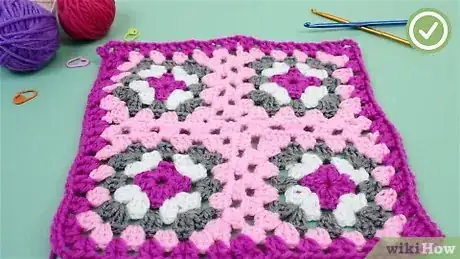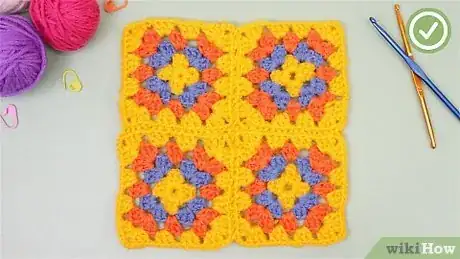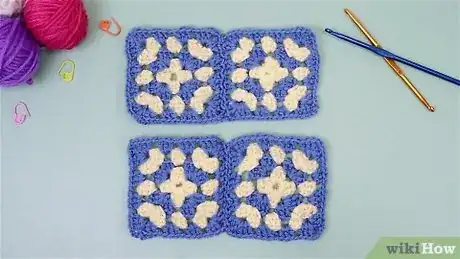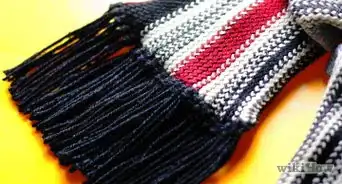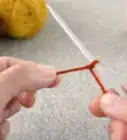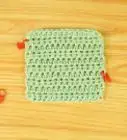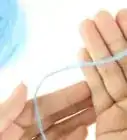X
wikiHow is a “wiki,” similar to Wikipedia, which means that many of our articles are co-written by multiple authors. To create this article, 12 people, some anonymous, worked to edit and improve it over time.
This article has been viewed 147,111 times.
Learn more...
Crocheted granny squares can be attached to each other by crochet techniques or sewing techniques. There are a variety of options you can use, but here are a few simple yet elegant ones to start with.
Steps
Method 1
Method 1 of 4:
Slip Stitch (Crocheting)
-
1Match up the squares. Place two granny squares together, one on top of the other, with the ride sides facing together.[1]
- This method will create a secure seam that is strong enough to hold together large pieces.
-
2Slipknot the yarn onto your crochet hook.
- Make a slip knot by creating two loops side by side. Push one loop through the other and pull, forming a single loop. This becomes an adjustable knot. After making this slipknot on one end of the yarn, let the loop be bigger than the tip of your hook. Place your crochet hook into the loop, then pull gently on the long end, till the loop is gently snug around the hook.
Advertisement -
3Place the squares face to face. Doing so lets you see the edges side by side. Note that the 'back loop' of the square closest to you truly looks like the 'back loop' of that square; but the 'back loop' of the next square is actually the very next loop, the one touching the loop you are getting ready to use by following the instructions right now. Insert the hook through the back loop of both squares on the upper right side. With your hook, grab the yarn from the other side of the back loops and pull the yarn through to form a second loop on the same side as the yarn you are using to join the squares. TIP: Use a contrasting color to practice with. This will let you see clearly where you are placing each stitch. Some people like to use a contrasting color the entire time. This creates a nice pattern.
- Note that the first loop on your joining yarn, at this point, is the loop you created with your slipknot. This loop now sits over the crochet hook.
-
4Use the hook to pull the second loop through the first loop, this is called a 'slip-stitch'. This will create the first slip-stitch of your process of joining.
-
5Continue along the rest of the side/edge. You will be forming one slip-stitch for each back loop.
- Do not crochet too tightly. Slip-stitches need to be worked a bit loosely as they do not stretch much. As a result, worked tightly, they can make your project 'bunch up' or not be very flexible.
-
6Add more squares and rows as needed. You can attach more squares to your original two squares using this same method around the other edges. Expand the blanket, scarf, or other project outward by adding one square at a time.
- Finish the piece with a border or by weaving the end/tail of the yarn back into the final seam to hide it. This will keep the yarn secure.
Advertisement
Method 2
Method 2 of 4:
Granny Join (Crocheting)
-
1Match up the squares.[2] The first square in your row should be placed on the left and the second square should be placed to its right. The second square should be on top, and the back sides of both squares should be facing each other.
- Note that if you have a layout or pattern in mind, you should arrange it before you crochet your rows together.
- Stack the first row together. The last square in that row should go on the bottom and the first should go on top. Smaller stacks are easier to work with.
- This method will create a flexible, decorative seam between the squares.
-
2Knot the yarn onto your crochet hook. Make a slipknot on one end of the yarn and squeeze your crochet hook into the loop created by the knot.
- Make a slip knot by creating two loops side by side. Push one loop through the other and gently pull them in opposite directions, forming a single loop with an easy-to-adjust knot.
-
3Chain stitch three times in the corner of the top square. Make a slipknot over the open corner of your top granny square. Chain stitch three times off this corner.
-
4Double crochet three times in the corner of the bottom square. Connect the bottom square to the top square by making three double stitches (double crochets) in the open corner of the bottom square.
- You might need to change the way you hold the two squares together as you stitch them together. If you have trouble stitching them together with one on top of the other, turn the two squares on the side so that the shared edges are facing up toward you. The "top" square will now be on your right and the "bottom" will be on the left.
-
5Double crochet in the next space of the top square, followed by the next space of the bottom. Make three double crochet stitches in the next open space of the top/right square. After those are complete, make another three double crochet stitches in the next open space of the bottom/left square.
- Continue across the shared sides of the two squares using this technique. Alternate back and forth, making sets of three double-stitches in each open space along the edges of both squares.
-
6Make one double crochet in the corner of the back square. When you reach the end of the joined row, make one double stitch crochet in the final open corner.
- Bind or knot it off to finish the joint.
-
7Repeat with any remaining squares for the row. Follow the same same procedure to stitch together all the squares in each row.
- Also repeat the procedure for each stack (or row) of granny squares.
-
8Lay rows next to each other. Work with two rows at a time. Place the rows together with the backs facing each other.
- The principle for joining the rows together is essentially the same principle used for joining individual squares.
-
9Double crochet rows together. Follow the same pattern you used when joining the individual squares. Make three chain stitches in the corner of the front row, followed by three double stitches in the corner of the back row.
- Make sets of three double-stitches, alternating back and forth between the open spaces of the two rows until you reach the end.
- The join between two squares should be treated as any other open space, and you should make three double stitches there, too.
-
10Make one granny row around the finished piece. Once all the squares and rows have been joined together, make sets of three double-stitches all around the perimeter of the piece to finish it and even out the edges.
Advertisement
Method 3
Method 3 of 4:
Whip Stitch (Sewing)
-
1Match up the granny squares. Place two granny squares on top of each other with the right sides facing together.
- This method is quick and easy, and as long as you keep the stitches fairly loose, it makes the seam very flexible and soft.
-
2Thread your needle. Thread a large darning needle with yarn. Insert one end of the yarn through the eye of the needle and pull enough of it through to prevent the needle from becoming un-threaded during the joining process.
- You do not need to knot the yarn, but you may do so if you have difficulty keeping the yarn on the needle. Knot the short end of the yarn to the opposite side of the yarn, just past the portion which passes through the eye of the needle.
-
3Start at the upper right corner. Pull the thread through the the back loop in both the top and bottom squares.
- Do not pull the yarn all the way through since there is no knot on the end of the yarn to hold it in place.
- Leave enough yarn at the end after pulling the rest through to either knot or use in attaching another square, depending on whether this square is on the end of a row or in the middle, respectively.
-
4Weave the yarn through each back loop on one side. Bring the needle over the edge of both squares and into the next back loop of the top square. Push it through the loops of both the top and back squares once more.
- Repeat this with the next set of back loops. You are essentially sewing the squares together using a whip stitch, or a type of stitch that stitches over the edge of the material rather than before the edge.
- Continue sewing this top edge of the two squares together to connect them together.
-
5Add more squares as needed. After the two squares have been joined together, you can use the same technique to join squares to the other sides of the same two squares. Expand your squares out in whichever direction you need to in order to add rows in both directions.
- Knot the yarn to the back edge of the final square once you have finished stitching them together.
Advertisement
Method 4
Method 4 of 4:
Invisible Stitch (Sewing)
-
1Line up the squares. To start with, you should line up two of your squares side by side. These will be the squares you join first.[3] [4]
- It might be a wise idea to lay out all your squares first, however, so that you can see how everything will flow together.
- All the squares should be lined up with the right side facing up.
- It is also recommended that you start with the bottom pair of squares in the middle row of your overall project.
- This method will create another flexible joining seam, but unlike the whip stitch, this stitch will be hidden from both sides of the finished project.
-
2Thread your needle. Thread a large darning needle with yarn. Insert one end of the yarn through the eye of the needle and pull enough of it through to prevent the needle from becoming un-threaded during the joining process.
- Do not knot the yarn at this point in time.
- Use yarn that is slightly thinner than the yarn you used to make your granny squares.
-
3Weave your needle into the bottom left edge of the first square. Pick up the right-hand square of your first pair. Slide the needle up and through the bar on the edge of the square in the bottom left side of that square.
- The "bar" refers to the connecting thread lying between the front and back pieces of yarn of the square. This bar can only be seen from the side of the square.
-
4Weave your needle into the bottom right edge of the second square. Pick up the square that goes to the direct left of the first square in your sequence. Weave the needle up and through the bar on the bottom right side of this square.
- Do not tighten the two squares together yet.
-
5Repeat along one edge. Weave the needle up and through the next bar along the shared edge of the first square. Then, weave it up and through the next bar along the shared edge of the second square.
- Continue sewing through the bars on both edges to connect the two squares together along one shared edge.
- Leave the stitches loose as you sew initially to make the process easier.
-
6Tighten the joining stitch. Grab both hanging ends of the joining yarn. One should hang from the bottom and the other should hang off the top. Pull the top end up and the bottom end down to tighten the seam and draw the two squares closer together.
- With this step, the seam should become "invisible" or hidden in between the two squares.
-
7Repeat with the next two squares. Grab the next two squares in your sequence and repeat the same procedure to join them together.
- The next pair should connect to the top of the first pair.
- Use the yarn hanging off the top of the first pair to join the second pair together. Doing so will also connect the second pair to the first.
-
8Attach additional squares horizontally or in vertical pairs. When expanding the piece vertically, you need to do so in pairs, as you did when connecting the second pair to the first. When expanding the piece horizontally, you can do so by attaching a single square to the empty left or right side of the original square using another invisible stitch.
- When done, knot the yarn to the back edge of the final square.
Advertisement
Community Q&A
-
QuestionCould I use fishing line?
 LibraryMouseCommunity AnswerNot a good idea. It might rip the yarn or pull it out of shape. And it won't be very comfortable.
LibraryMouseCommunity AnswerNot a good idea. It might rip the yarn or pull it out of shape. And it won't be very comfortable. -
QuestionDo I need to weave in the ends as normal?
 Community AnswerYes, that will keep your work in place.
Community AnswerYes, that will keep your work in place. -
QuestionDo you have instructions for shell stitch on baby afghans?
 MicheleTop AnswererShell stitch is very easy. It's simply dc 3 or more times in the same stitch, sk st, sc next st, sk st, dc 3 or more times in next stitch. There's your basic shell stitch.
MicheleTop AnswererShell stitch is very easy. It's simply dc 3 or more times in the same stitch, sk st, sc next st, sk st, dc 3 or more times in next stitch. There's your basic shell stitch.
Advertisement
Things You'll Need
Crochet Methods
- Yarn
- Crochet needle
Sewing Methods
- Yarn
- Darning needle
References
- ↑ http://www.craftsy.com/blog/2013/07/how-to-join-granny-squares/
- ↑ http://carinascraftblog.wardi.dk/2009/06/granny-square-joining-tutorial.html
- ↑ http://doyoumindifiknit.typepad.com/do_you_mind_if_i_knit/2010/02/joining-up-with-an-invisible-stitch.html
- ↑ https://www.pinterest.com/pin/81768549454293315/
About This Article
Advertisement
